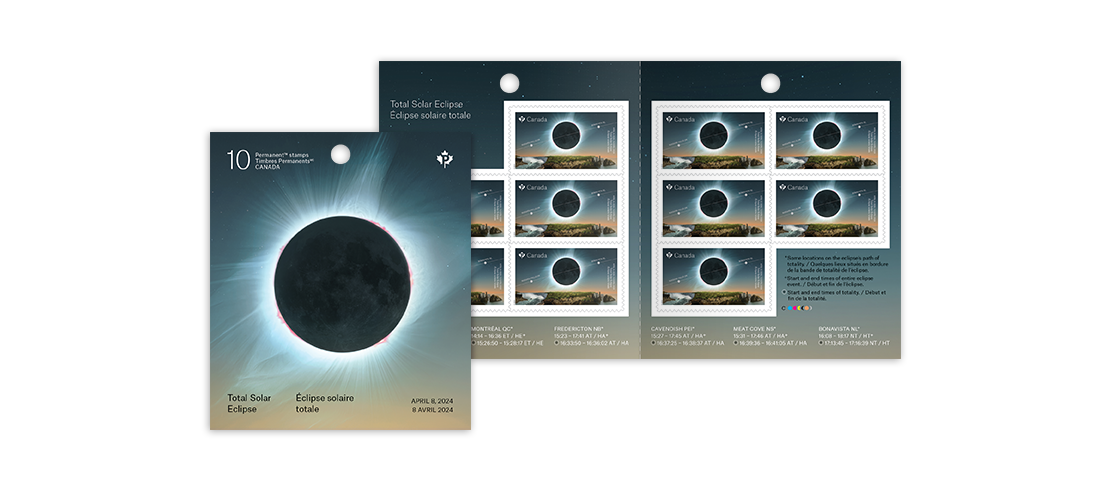Canada Post will issue its first-ever eclipse stamp on March 14, 2024, to herald the arrival of a total solar eclipse. On April 8, the path of the eclipse will pass through parts of North America’s three largest countries – Mexico, the United States and Canada – for the first and only time this century. While the awe-inspiring phenomenon occurs about twice every three years, it is only visible from a given location on Earth approximately once every 400 years, on average.
“A total solar eclipse is, by far, the most amazing natural event you’ll ever see,” says Randy Attwood, former executive director of the Royal Astronomical Society of Canada, who has chased 10 such eclipses across six continents. “You may think you know what to expect, but the real thing is much more overwhelming. Once you’ve seen one, you’re hooked.”
A total solar eclipse occurs when the moon completely blocks out the face of the sun. The spectacle unfolds over approximately two hours but peaks in only a few precious minutes of totality, when the sun is obscured from view and the ghostly glow from its chromosphere and corona frames a perfect silhouette of the moon.
The eclipse stamp was created by designer Richard Nalli-Petta using a combination of photography and illustration. Printed with a special spot-gloss varnish that glows when exposed to black light, it shows the eclipse set against a darkened sky. A thin silver line depicts its path across Canada, and a collage along the bottom of the stamp highlights some of the landscapes over which it passes – including Ontario’s Niagara Falls and Spillars Cove in Newfoundland and Labrador.

While many eclipses take place over uninhabited regions, this one will pass over populated areas in six provinces, as well as many other parts of the continent. In Canada, the phenomenon – which won’t be seen here again until 2044 – will trace a path approximately 200 kilometres wide, from southwestern Ontario to eastern Newfoundland and Labrador. Weather permitting, millions of Canadians directly along the route will see daylight turn to darkness as it passes overhead, while those who are not too far outside of its path will see a partial eclipse.
The most dramatic changes to the environment occur during the 10 minutes or so leading up to totality. The sky turns yellow. Shadows sharpen. Leaves cast tiny, crescent-shaped shadows on the ground. “In the seconds before totality, the world changes completely. The temperature drops, and a breeze may come out of nowhere,” says Attwood. “You might even see what looks like a massive thunderstorm approaching – but it’s actually the moon’s shadow, racing toward you at over 1,600 kilometres an hour.”
Humans aren’t the only ones affected by the experience. Attwood explains that, as the sky gradually darkens, some animals begin to behave as if night is falling. “In 1991, I was in Baja California for an eclipse and all these roosters started crowing,” he says. “It’s not unusual to hear crickets chirp – or to see birds heading back to their roosts and bats coming out to hunt.”
What was once considered an evil omen by some now draws crowds of eclipse-chasers from around the world. Although he’s a veteran viewer, Attwood says he still gets a thrill every time he sees an eclipse and loves the reaction of people who are watching one for the first time. “People literally freak out – some people start counting down, others start yelling and pointing,” he says. “When totality is all over, people applaud and some even shed a few tears!”
WARNING
Looking at the sun without proper protection can cause serious eye damage. For more information on eye safety during the eclipse, visit https://www.asc-csa.gc.ca/eng/multimedia/search/video/18873

New stamp celebrates arrival of historic total solar eclipse
Available now